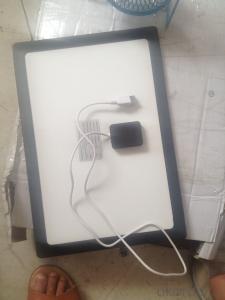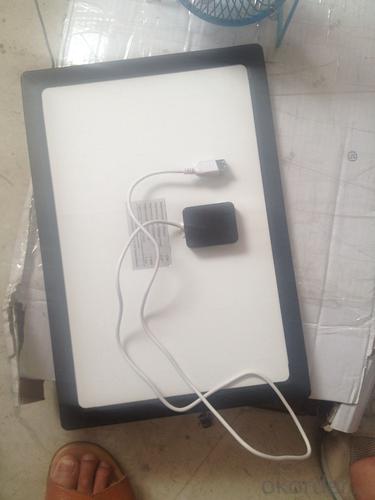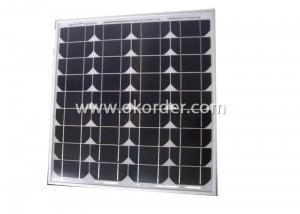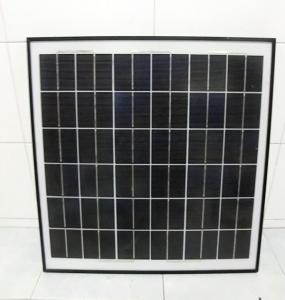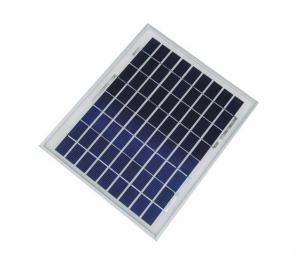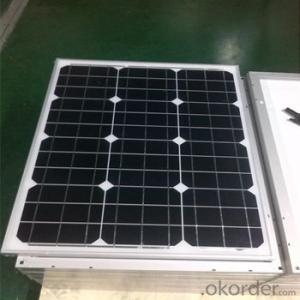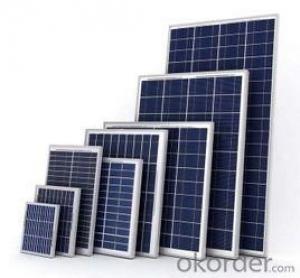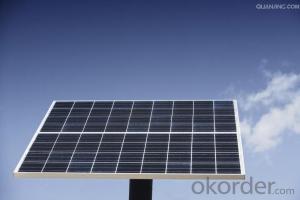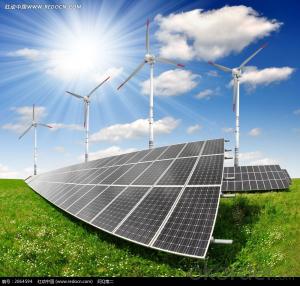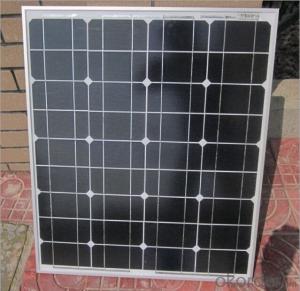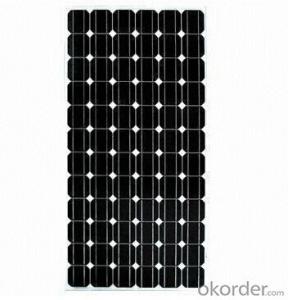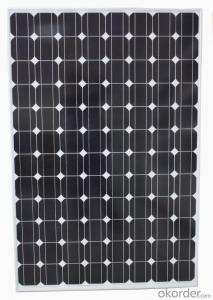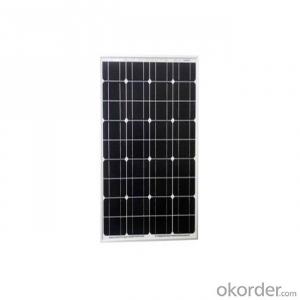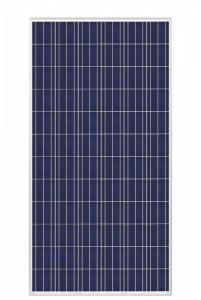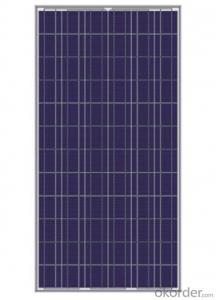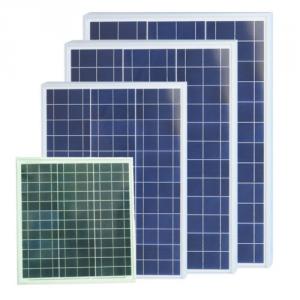Solar Panels Kissimmee FL - Monocrystalline Solar Panels 30W for Solar Systems
- Loading Port:
- Shanghai
- Payment Terms:
- TT or LC
- Min Order Qty:
- 10000 watt
- Supply Capability:
- 50000000 watt/month
OKorder Service Pledge
OKorder Financial Service
You Might Also Like
Product Description
Solar Monocrystalline Series Panels
Introduction of Monocrystalline Solar Panels
CNBM Solar photovoltaic (PV) Panel is designed for large electrical power requirements. It is the optimal choice for both on-grid and off-grid power systems. CNBM Solar panel offers high performance of power per square foot of solar array. Monocrystalline silicon(c-Si): often made using the Czochralski process. Single-crystal wafer cells tend to be expensive, and because they are cut from cylindrical ingots, do not completely cover a square solar cell module without a substantial waste of refined silicon. Hence most c-Si panels have uncovered gaps at the four corners of the cells.
Characteristics of Monocrystalline Solar Panels
I Solar Cell : High efficiency crystalline solar cell. Even if under the weak light, the solar module can produce maximum power output.
II Tempered glass (toughened glass): Anti-reflecting coating and high transmission rate glass increase the power output and mechanical strength of solar module.
III EVA and TPT: Using high quality EVA and TPT to prevent destroying and water.
IV AI frame: Without screw, corner connection. 6 holes on the frame can be installed easily.
V Junction box: Multi function junction box with water proof.
VI Long lifetime: ≥25 years; Less power decrease
VII Good performance of preventing from atrocious weather such as wind and hails.
VIII Resisting moisture and etching effectively, not effected by geology.
Standard Test Conditions of Monocrystalline Solar Panels
The opto-electrical specifications shown below are stabilized values being measured at Standard Test Conditions, Irradiance: 1000W/m2, Spectrum: AM1.5 at 25°C, The info below is subject to manufacturing tolerances. Where appropriate minutes of measurement are available and are used for the dimensioning of the installation.
Advantages of Monocrystalline Solar Panels
1.High reliability with guaranteed -3% to +5% power output tolerance, ensuring return on investment
2. High conversion efficiency based on leading innovative photovoltaic technologies
3. Withstands high wind-pressure and snow load, and extreme temperature variations
4. Attractive appearance Unique frame design, high mechanical strength, and easy Installation
Characteristics of Monocrystalline Solar Panels
Max Power Voltage Vmp (V) | 17.6V | 17.2 V |
Max Power Current Imp (A) | 1.71A | 2.33A |
Open Circuit Voltage Voc (V) | 22.6V | 22.2V |
Short Circuit Current Isc (A) | 1.83A | 2.48A |
Max Power Pm (W) | 30W | 40W |
Temperature Coefficient of Cells
NOCT | 47℃±2℃ |
Temperature Coefficients of Isc (%/℃) | 0.06 |
Temperature Coefficients of Voc (%/℃) | -0.33 |
Temperature Coefficients of Pmp (%/℃) | -0.45 |
Mechanical Data Solar Monocrystalline Series
Power | 90W/100W |
Dimension | 510×450×25mm/610×510×25mm |
Weight | 2.7 kg/ 3.7kg |
Tolerance | ±3% |
The dimension of the modules can be changed according to the demand of clients Limits.
Operating Temperature | –45 °C to +80°C |
Storage Temperature | –45 °C to +80°C |
Max System Voltage | 700V |
Guarantee Solar Monocrystalline Series Panels
Products Guarantee | 2 years free from defects in materials and workmanship |
Performance Guarantee | No less than 90% within 10yrs and no less than 80% within 25yrs |
Certificates | IEC, ISO, TUV, CE |
Dimension of Solar Monocrystalline Series Panels
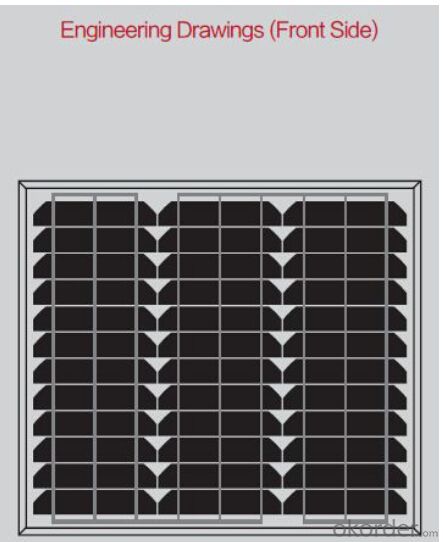
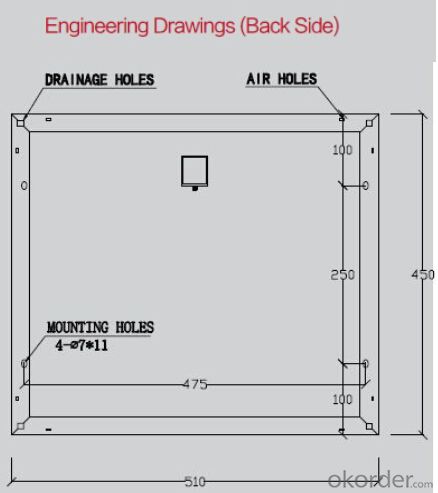
FAQ
We have organized several common questions for our clients,may help you sincerely:
1. What’s price per watt?
A: It’s depends on the quantity, delivery date and payment terms of the order. We can talk further about the detail price issue. Our products is high quality with lower price level.
2. Can you tell me the parameter of your solar panels?
We have different series of cells with different power output, both from c-si to a-si. Please take our specification sheet for your reference.
3. How do you pack your products?
We have rich experience on how to pack the panels to make sure the safety on shipment when it arrives at the destination.
4. What is your warranty system?
Our product performance guarantees for 25 years
• 12 years guarantee for workmanship
• Timeliness of delivery
• Quality Products certified (TÜV, UL, CE, ISO)
5. How do you pack your products?
We have rich experience on how to pack the panels to make sure the safety on shipment when it arrives at the destination.
It wasn't too long ago that the idea of generating electricity from the sun was a scifi dream, when it did become a reality it was mostly seen in small appliances, such as the humble desk top calculator. The sheer cost of solar panels for generating an alternative electricity supply for the home put the idea way beyond the reach of most home owners. But today, as solar cells are easier and cheaper to produce, solar panels are more popular. Of course, this interest is driven by a steady increase in the cost of National Grid power and a growing awareness of the damage traditional methods of power generation does to the environment.
Solar panels are created from multiple solar cells, the more energy we want to generate, the bigger the panel and the more cells we need. A solar cell is usually made from slices of silicon, the same as used in a CPU, which are mounted underneath a non reflective base, usually glass. Each solar cell generates a small current. However, if we link a sufficient number of these cells together we can increase the current proportionally. In this way we can increase the wattage to a level high enough to at least partially support an average household's electric usage, or even end their dependency on the local cable electricity supply.
So in short, when light strikes silicon it creates a small current, this current can be increased by linking many cells together in a panel. A solar panel. If you want more electricity, you simply add more panels.
There is a mathematical formulae for calculating the amount of watts generated so installers can easily estimate how many panels you want once they know your electricity consumption.
There are a couple of ways to have solar energy run your house, one is by installing ready made panels, bought from a hardware shop. You can have a trades person install them or do it yourself.
DIY is the second alternative to connecting your power needs to the sun, with a few tools a little knowledge of carpentry and common sense. You will need to buy solar cells, but after that you can build your own solar panels with very little effort.
- Q:How do solar panels impact air pollution?
- Solar panels have a positive impact on air pollution as they produce clean energy without emitting harmful pollutants or greenhouse gases into the atmosphere. By replacing fossil fuel-based energy sources, solar panels help reduce air pollution and improve air quality, resulting in a healthier and more sustainable environment.
- Q:Can solar panels be installed on a university or college campus?
- Yes, solar panels can be installed on a university or college campus. In fact, many educational institutions have already embraced solar energy as a way to reduce their carbon footprint and promote sustainability. Installing solar panels on campus buildings can provide clean, renewable energy, reduce electricity costs, and serve as an educational tool for students to learn about renewable energy technologies.
- Q:Which kit did you use?How easy was it to build? How much did it cost to build the panels?How many kw or watts does it produce?Any other info on the kit or panels you built would be helpful.Thanks!
- the kit is a fraud and should be ignored. You cannot make a solar panel at home to the quality and output that professional ones are. It's like thinking you can buy chips and make your own PC.
- Q:So I want to go completely solar. Do I need the connected solar panels alone for after sundown hours; Do I need something else in order to have energy to run my entire house throughout the night?In other words do solar panels store the energy for after sun-down or do I need other devices to store the energy?
- Solar okorder
- Q:Can solar panels be used in areas with limited access to electricity?
- Yes, solar panels can be used in areas with limited access to electricity. Solar panels can generate electricity from sunlight, allowing them to provide a reliable source of power in remote or off-grid locations. These areas can benefit greatly from solar energy as it is a sustainable and renewable resource that can help meet their energy needs.
- Q:Can solar panels be damaged by birds or other animals?
- Yes, solar panels can be damaged by birds or other animals. Birds may build nests or perch on the panels, causing blockage of sunlight and reducing their efficiency. Additionally, animals like squirrels or raccoons may chew on the wires or cables, leading to electrical damage. To prevent such issues, various measures like installing bird deterrents or using protective mesh can be taken.
- Q:Can solar panels be used in areas with frequent power outages?
- Yes, solar panels can be used in areas with frequent power outages. Solar panels generate electricity from sunlight, so as long as there is sunlight available, they can continue to produce power even during power outages. Additionally, solar panels can be equipped with battery storage systems to store excess energy generated during the day for use during periods of low sunlight or power outages, making them a reliable source of electricity in areas with frequent power disruptions.
- Q:Can solar panels work at night?
- No, solar panels cannot work at night as they rely on sunlight to generate electricity.
- Q:Can solar panels be installed on a building with historical significance?
- Yes, solar panels can be installed on a building with historical significance. However, it is important to consider the potential impact on the building's aesthetics and historical value. Careful planning and consultation with preservation experts can help ensure that the installation is done in a way that minimizes any negative visual or structural impact on the building while still harnessing the benefits of solar energy.
- Q:in the afternoon sun heat increases to high level due to which the panels heats up very high now my question is this heat will effect the panels life time and will damage the panels or not ??
- They degrade over time, losing efficiency. They're generally good for several decades.
1. Manufacturer Overview |
|
|---|---|
| Location | |
| Year Established | |
| Annual Output Value | |
| Main Markets | |
| Company Certifications | |
2. Manufacturer Certificates |
|
|---|---|
| a) Certification Name | |
| Range | |
| Reference | |
| Validity Period | |
3. Manufacturer Capability |
|
|---|---|
| a)Trade Capacity | |
| Nearest Port | |
| Export Percentage | |
| No.of Employees in Trade Department | |
| Language Spoken: | |
| b)Factory Information | |
| Factory Size: | |
| No. of Production Lines | |
| Contract Manufacturing | |
| Product Price Range | |
Send your message to us
Solar Panels Kissimmee FL - Monocrystalline Solar Panels 30W for Solar Systems
- Loading Port:
- Shanghai
- Payment Terms:
- TT or LC
- Min Order Qty:
- 10000 watt
- Supply Capability:
- 50000000 watt/month
OKorder Service Pledge
OKorder Financial Service
Similar products
Hot products
Hot Searches
Related keywords
